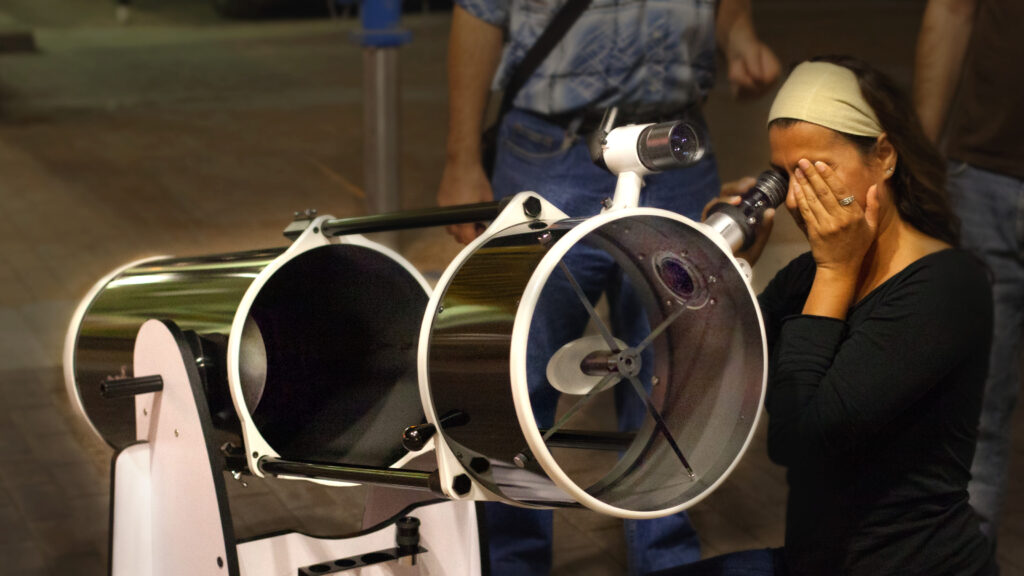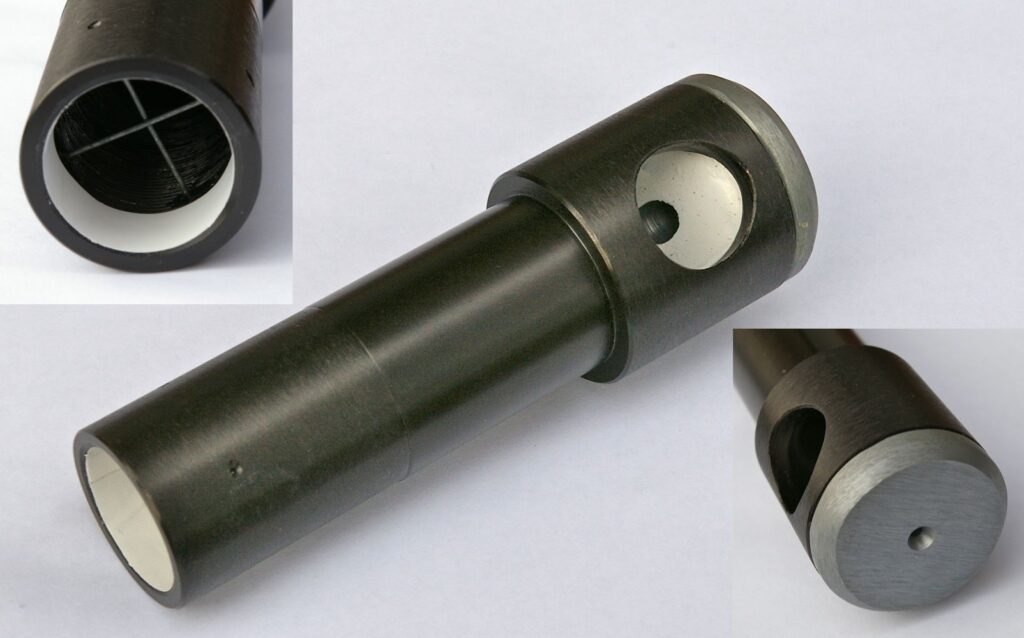In this price category, roughly between €300/$300 and €1,000/$1,000, you will find good mid-range telescopes that you will not get tired of quickly. There are also telescopes that help you find and track your observing targets with the help of a computerised mount. This is an article in a series on the best telescopes for every budget .
What to expect?
Telescopes in this price category roughly fall into two types: telescopes that you have to operate manually but have a huge capacity to collect light, and telescopes that are smaller in aperture but have all kinds of tools to find and observe an object with the help of a built-in computer.

This drawing gives a good idea of the amount of detail that can be seen by an experienced observer with a telescope of 200mm diameter or more (image: E. L. Trouvelot/Rawpixel)
Especially with telescopes with a large aperture, stargazing is a joy: you’ll see plenty of structure in nebulae like the Orion Nebula, bright star clusters are resolved completely into individual stars, you’ll see glittering stars at the edges of some globular clusters and Jupiter shows a lot of detail in the cloud cover and you can observe shadow transitions of its moons. Distant galaxies often remain fuzzy patches, even with telescopes with a larger aperture, but detecting such a galaxy at a distance of millions of light years remains a special experience.
Especially with telescopes with a large aperture, stargazing is a joy
With computerised telescopes within the budget you see a little less because of the smaller aperture, but the ease of finding and tracking your observing targets largely makes up for it. Ultimately, it’s is a personal choice. In this article I will take you through both categories and try to provide you with the most important points of attention, so that you can make a solid choice.
Full-size dobsons
If you poke around discussion forums about telescopes or astronomy, you’ll notice how often a full-size dobsonian telescope is recommended for beginners . There is a good reason for this: dobsonian telescopes are simple telescopes that open up a whole world of astronomical observations for a manageable budget.
Dobsonian telescopes are simple telescopes that open up a whole world of astronomical observations for a manageable budget
Because dobsons are relatively simple telescopes, they offer the most bang (aperture) for the buck. A dobsonian with an aperture of 150 mm or more brings so many dim objects and planetary detail within reach that it could be a telescope you can use for a lifetime without getting bored .
Read on to find out what to look for when choosing a suitable dobson, or jump straight to Waddensky’s choice!

What to look for when purchasing?
There are only a small number of manufacturers that make dobs for the mass market. The most important are the Asian companies Synta and GSO. The telescopes that these companies make are sold under various brand names all over the world. So you can come across almost identical dobs with a different label.
Optically, they are all about the same quality. It doesn’t matter which brand you buy. What often differs per brand are the accessories that are included with the scope.
In general, with telescopes, the larger the aperture, the better. A larger aperture is able to ‘catch’ more light and focus it on your eye, so you can observe fainter objects with it. In addition, a telescope with a larger aperture has a higher resolution, which means you can see more detail with it.

Dobsons offer the best value for the money when it comes to aperture. But pay attention to the weight and size of the telescope! Dobson’s can be big and heavy, especially with larger apertures. If you have limited storage or transport space, dobs with a flexible tube that can be collapsed (so-called ‘flextubes’) are suitable. These take up a lot less space. Keep in mind that flextube telescopes are often heavier, have to be collimated regularly and may suffer from stray light.
If you have limited storage or transport space, dobs with a flexible tube that can be collapsed (so-called ‘flextubes’) are suitable
Dobsons come standard with everything you need to start stargazing, in principle you do not need any extra investment to begin with (except for a collimation aid, see further in this article). Because the included accessories differ per brand, it is good to pay attention to this when purchasing. For example, some telescopes come with two eyepieces, so you can immediately observe at two different magnifications. Others have a dual-speed focuser, which is useful for focusing with extra accuracy. Some other telescopes have a RACI finderscope, which is more ergonomic and intuitive to use than a regular optical or red dot finder. All these accessories can also be purchased separately later.
Collimating is an easy job once you get the hang of it and requires few tools
An important point of attention with dobsons is that the mirrors must be regularly aligned. This is called collimating. This is an easy job once you get the hang of it and it requires few tools. If you hardly transport your telescope and handle it with care, it really isn’t necessary to collimate before every observing session. But there are observers who check and adjust the mirrors before each session.

Waddensky’s choice
Europe
- Sky-Watcher 150/1200 Skyliner Classic
- Sky-Watcher 200/1200 Skyliner Classic
- Sky-Watcher 254/1200 Skyliner Classic
- Sky-Watcher 254/1200 Skyliner FlexTube
- GSO N 300/1500
USA
Computerised telescopes
Computerised telescopes are telescopes equipped with tools to find and (sometimes) track observing targets so that they remain in view. Read on to learn about the different types of computerised telescopes or jump to Waddensky’s choice!
What to look for when purchasing?
There are two types of computerised telescopes: GoTo and PushTo.
GoTo does exactly what it says: you select an object via a hand controller or smartphone, and the telescope aligns itself with the help of built-in motors, so that the requested object is in the centre of the field. The telescope then continues to follow the object, so that you are able to view it without having to adjust the telescope.

A PushTo mount does not contain motors to move independently, but gives you instructions on the hand controller to find an object yourself by pointing the telescope at it by hand. The telescope remembers in which direction you have moved the telescope, so that when you select the next object, you only have to follow the instructions on the controller again to centre on your new observing target. PushTo is actually a kind of middle ground between a fully manual telescope and a fully automatic GoTo.
PushTo is actually a kind of middle ground between a fully manual telescope and a fully automatic GoTo
Both types of mounts (GoTo and PushTo) require you to enter your location and the date and time (some mounts have a GPS receiver so entering your location manually is not necessary). You also need to align the telescope to a number of known stars before observing so that the telescope knows how it is positioned in relation to the night sky. In short, you have some preparatory work before you can start observing.
Both types of telescopes also need a power source. The PushTo systems can suffice with a simple battery, which often lasts several nights. The fully motorised GoTo telescopes obviously need more power (a lot of batteries, or an external battery).
GoTo and PushTo telescopes are smaller in this price category than telescopes that you operate entirely by hand
All computerised functions of these telescopes are extras. They therefore ‘consume’ part of your budget, leaving less for the aperture and therefore the light-gathering capacity of the telescope. That is why GoTo and PushTo telescopes in this price category are smaller than telescopes that you operate entirely by hand. So if you’re on a budget, the choice is between a larger telescope without a computer, or a smaller telescope that helps you find and track observing targets. The choice is yours!
Waddensky’s choice
Europe
- Sky-Watcher Heritage 150P Flextube (Virtuoso GTi)
- Celestron Astro Fi 102 Maksutov
- Celestron Astro Fi 130
USA
- Sky-Watcher Heritage 150P Flextube (Virtuoso GTi)
- Celestron Astro Fi 102 Maksutov
- Celestron Astro Fi 130
If you make a purchase through one of the links on this page, Waddensky receives a small compensation from the webshop for forwarding visitors. This does not change the price for you, but the compensation allows Waddensky to continue to provide you with valuable information on astronomical topics. Thanks in advance for your support!